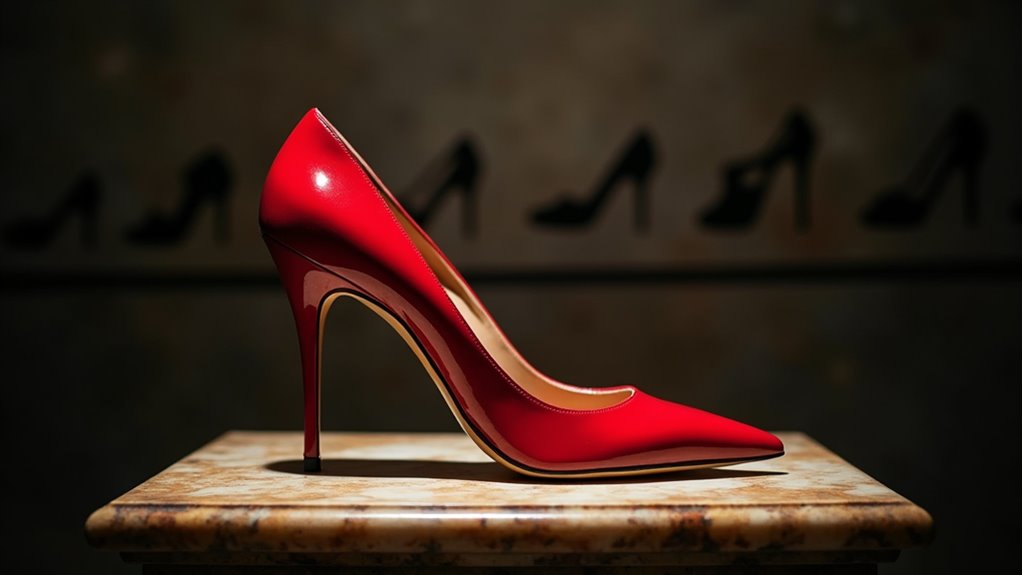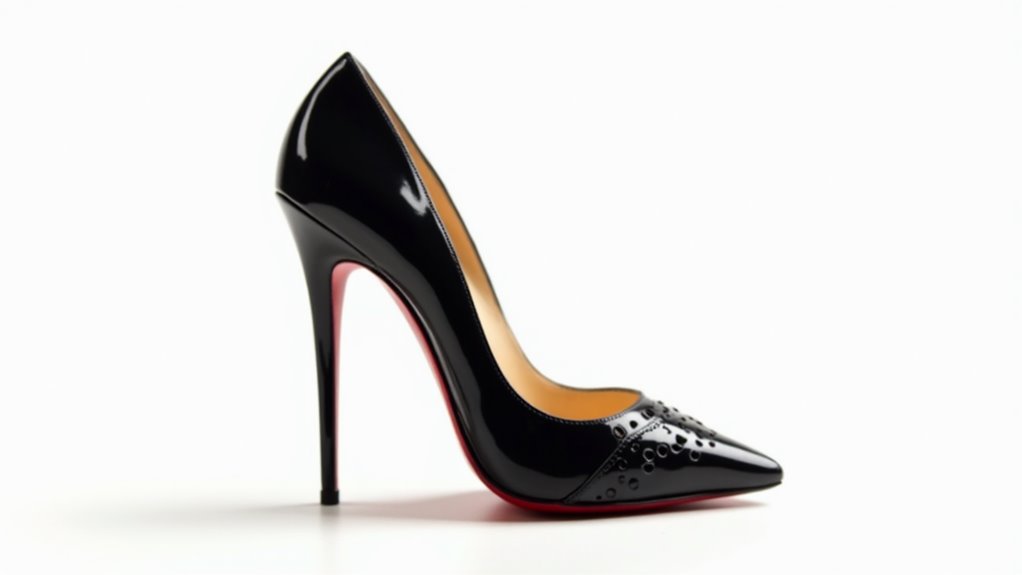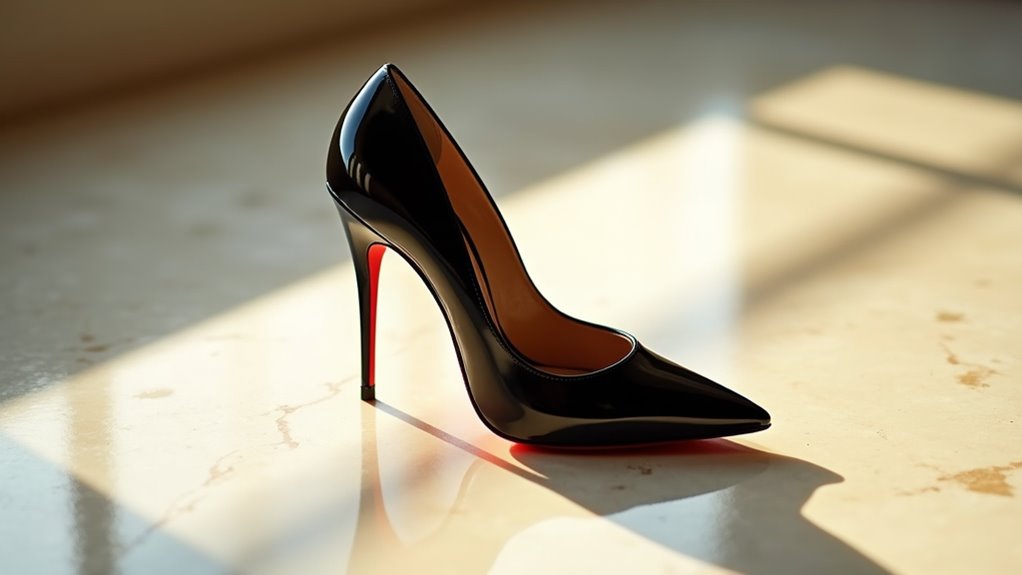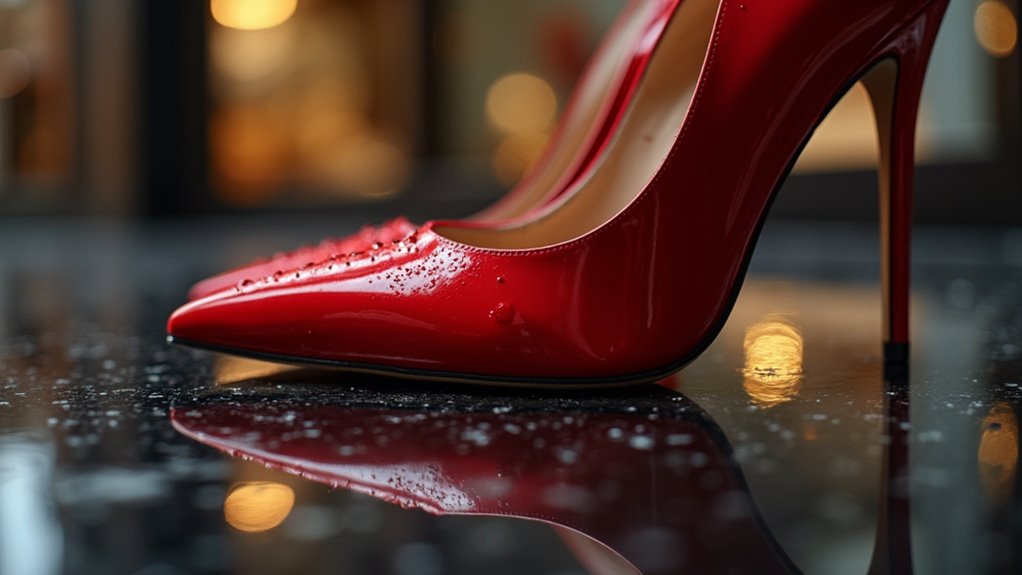There may be products. Products are independently selected by our editors. We may earn an affiliate commission from the links with no charge to you, example: as Amazon Affiliate.
We’ve witnessed stilettos’ transformation from their 1950s debut by Roger Vivier into powerful symbols of status and strength. These iconic shoes command attention through their distinctive click, boost confidence through enhanced posture, and create an undeniable presence in both social and professional settings. Research shows stilettos increase social interactions by 36.3%, while their craftsmanship has evolved to blend comfort with sophistication. From Persian cavalry wear to modern luxury statements by designers like Louboutin, stilettos continue to represent the complex interplay of power, gender dynamics, and cultural status. Their enduring allure holds countless fascinating dimensions waiting to be discovered.
Key Takeaways
- Stilettos enhance confidence and self-assurance by improving posture, height, and overall presence in social and professional settings.
- The distinctive clicking sound of stilettos commands attention and creates an aura of authority in social environments.
- Research shows stiletto wearers receive increased attention and assistance, demonstrating their powerful impact on social interactions.
- Luxury brands like Louboutin elevate stilettos to status symbols, making them desirable markers of prestige and sophistication.
- Stilettos create an elongated silhouette that enhances perceived attractiveness while symbolizing modern feminine power and independence.
The Historical Journey of Stilettos

The stiletto heel burst onto the fashion scene in the 1950s, marking a revolutionary moment in footwear design. When Italian designer Roger Vivier collaborated with Christian Dior’s “New Look” collection, he transformed the landscape of women’s footwear by creating the first practical stiletto design. This innovation wasn’t merely about aesthetics; it represented a significant shift in how we viewed femininity and fashion.
We can trace the stiletto’s evolution through the decades, watching as it morphed from a purely fashion statement into a powerful symbol of confidence and independence. By the 1970s, as women stepped into professional roles with increasing frequency, stilettos took on new meaning. They became more than just elegant footwear; they emerged as symbols of empowerment in the workplace.
Today, we’re witnessing stilettos’ enduring influence in contemporary fashion. Their characteristic slender heel, typically exceeding 4 inches, continues to emphasize the natural curves of women’s legs, just as Vivier intended. Through luxury brands and high-profile runway shows, these iconic heels maintain their status as quintessential elements of modern fashion, bridging the gap between classic elegance and contemporary style. For the professional woman, business formal heels remain an essential component of a polished office wardrobe.
Psychology Behind Their Magnetic Appeal
Delving into the psychological allure of stilettos reveals a fascinating interplay between perception, power, and social dynamics. When we examine the impact of wearing high heels, particularly stilettos, we find compelling evidence of their influence on both the wearer and observer. Studies consistently demonstrate that these shoes enhance perceived attractiveness and social presence, creating a complex psychological effect.
We’ve discovered that the relationship between confidence and femininity plays a crucial role in stilettos’ appeal. The distinctive clicking sound on hard surfaces commands attention, while the elevated posture naturally alters how women are perceived in social spaces. This transformation isn’t merely physical – it represents a form of feminine power that manifests in measurable ways. Research shows us that women in stilettos receive significantly more assistance from men, with an striking difference of 36.3% compared to those wearing flats.
The psychological impact extends beyond mere height enhancement. We’re witnessing how stilettos serve as cultural symbols of empowerment while simultaneously navigating complex gender dynamics. They’ve become powerful tools in social interactions, enabling wearers to project authority and confidence in various settings. For those seeking a more comfortable yet equally stylish alternative, braided material footwear offers a unique blend of sophistication and comfort.
Craftsmanship and Design Evolution

Let’s examine how stiletto design has evolved from its 1950s origins through meticulous refinements in both form and function. We’ve witnessed master craftsmen like Christian Louboutin and Jimmy Choo transform the basic stiletto silhouette into works of art, incorporating luxurious materials and intricate embellishments that command premium prices. Through decades of innovation, we’ve seen stilettos adapt to modern needs with enhanced comfort features while maintaining their distinctive slim profile and elegant aesthetic that made them iconic. Today’s online boutiques showcase an extensive collection of luxury pump designs that blend timeless sophistication with contemporary styling.
Iconic Design Elements Refined
Innovation in stiletto design marks a fascinating evolution from their 16th-century origins to today’s refined masterpieces of footwear engineering. We’ve witnessed iconic designers transform these heels into symbols of sophistication through meticulous craftsmanship and innovative techniques.
| Design Element | Impact |
|---|---|
| Height | Sculpts leg proportions |
| Materials | Ensures durability and comfort |
| Construction | Balances style with wearability |
| Signature Details | Creates brand recognition |
| Engineering | Supports proper weight distribution |
Today’s stilettos represent the pinnacle of fashion engineering, where designers like Christian Louboutin and Jimmy Choo have elevated your confidence through distinctive features. We’ve seen the integration of advanced materials and supportive insoles that maintain the delicate balance between aesthetics and functionality. The modern stiletto’s ability to enhance body proportions while incorporating sophisticated design elements demonstrates the remarkable progression from their historical roots. These iconic designers have mastered the art of creating heels that exceed 10 cm while ensuring structural integrity through precise craftsmanship. Their attention to detail, from the placement of embellishments to the careful selection of materials, continues to redefine what’s possible in high-end footwear design.
Handcrafted Excellence Through Time
Master craftsmen have shaped the evolution of stiletto design through decades of refined techniques and unwavering dedication to excellence. We’ve witnessed iconic designers like Christian Louboutin and Manolo Blahnik transform each pair of heels into a true work of art, elevating the standards of handcrafted excellence since the 1930s.
In examining the meticulous construction process, we can appreciate how modern artisans blend traditional skills with contemporary innovations. Today’s stilettos showcase precision engineering in their 4-to-6-inch heels, while incorporating premium materials such as exotic skins, fine leather, and luxurious silk. The addition of intricate embellishments further demonstrates the sophistication achieved through generations of refined craftsmanship.
We’re now seeing how technological advances have empowered craftsmen to push creative boundaries while maintaining the core principles of exceptional quality. This marriage of traditional handcrafting methods with modern design capabilities has resulted in stilettos that aren’t just fashion statements but masterpieces of engineering and artistic expression. Each shoe represents countless hours of detailed work, reflecting both the evolution of the craft and the enduring commitment to excellence that defines luxury footwear.
Cultural Impact Through Fashion
We’ve witnessed stilettos transform from 16th-century status markers into powerful symbols of modern fashion and femininity. Through centuries of cultural evolution, these iconic shoes have consistently reflected social hierarchies and beauty standards, particularly evident in how designer brands like Christian Louboutin have elevated them to ultimate fashion statements. Today, we’re seeing how stilettos continue to shape social dynamics and perceptions of power, as research shows women wearing high heels receive significantly more attention and assistance in public spaces. For the workplace, many professionals opt for polished dress shoes that balance style with comfort and professionalism.
Fashion’s Power Through Time
Through the centuries, high heels have wielded remarkable cultural influence, transcending their origins as mere footwear to become powerful symbols of status, gender, and social dynamics. We’ve witnessed their evolution from 16th-century European courts, where they served as markers of imperial authority, to their modern incarnation as emblems of feminine power and allure.
The act of wearing heels has consistently reflected society’s complex relationship with the feminine mystique. In the 1920s, as women’s roles began shifting dramatically, high heels transformed from practical footwear into deliberate fashion statements that could boost confidence and assert presence. We’ve seen how their varying heights and styles have mirrored changing attitudes about femininity and empowerment across different eras.
What’s particularly fascinating is how heels have maintained their dual nature as both status symbols and objects of desire. They’ve become deeply embedded in our cultural understanding of beauty and power, creating an intricate dialogue between fashion and social dynamics. As we examine their historical trajectory, we can’t ignore how they’ve shaped perceptions of femininity while simultaneously serving as tools for both empowerment and critique in modern fashion discourse.
Status Symbol Evolution
High heels’ remarkable journey from Persian cavalry wear to modern fashion statements exemplifies their enduring power as status symbols. We’ve witnessed their transformation from functional footwear to potent indicators of social standing, particularly during the cultural shifts of the 20th century.
The evolution of high heels as a status symbol has manifested in multiple ways:
- In the 1920s, wearing heels became synonymous with feminine empowerment and social mobility
- Their association with luxury brands elevated them to markers of economic success
- Professional environments adopted them as indicators of authority and competence
- Cultural influence transformed them into symbols of independence and strength
- Their presence in high fashion reinforced their status as luxury items
Throughout history, we’ve observed how the relationship between femininity and heel height has become increasingly complex. The 1970s marked a pivotal moment when heels became more than fashion choices – they emerged as cultural statements about gender identity and social power. Today, we recognize that while high heels continue to serve as powerful status symbols, they also generate important discussions about beauty standards and gender politics in modern society.
Walking Tall With Grace

Ever wondered why stilettos command such attention in a room? It’s not just about the height they add; it’s about the profound impact they have on how we carry ourselves and how others perceive us. When we wear heels, particularly stilettos, we’re engaging in a complex interplay of posture, body language, and social dynamics.
Despite concerns about back pain, research reveals that stilettos actually promote proper posture by encouraging an upright stance and core muscle engagement. As we master walking in these elegant shoes, we develop enhanced balance and poise that translate into graceful movement across any surface. The distinctive click of stilettos on hard floors isn’t just a sound; it’s an announcement of presence that commands attention and respect.
We’ve observed through studies that stilettos contribute significantly to perceived social status and attractiveness. The elongated silhouette created by these shoes doesn’t just add inches to our height; it transforms our entire bearing. When we wear heels, we’re not just elevating our physical presence; we’re embracing a tool that has historically symbolized confidence, sophistication, and personal empowerment. Modern innovations in comfort-focused design have revolutionized how we experience these timeless fashion statements.
Power and Social Dynamics
Walking dynamics shift dramatically when stilettos enter social spaces, creating complex power relationships that extend far beyond mere fashion choices. We’ve observed through research that the simple act of wearing high heels transforms social interactions, with men being nearly twice as likely to approach women in stilettos compared to those in flat shoes.
The power of stilettos manifests in multiple ways that shape social dynamics:
- The distinctive click-clack sound announces presence and commands attention in professional settings
- Enhanced height and posture project confidence and authority
- The glamour associated with heels influences others’ perceptions of status
- Increased self-assurance affects how women carry themselves and interact
- The transformation of body language creates subtle shifts in social hierarchies
Research by sociologist Jean-Claude Kaufmann confirms that stilettos significantly impact attraction and social dynamics. We’ve seen how these shoes serve as tools of empowerment, allowing women to navigate social spaces with enhanced confidence. The interplay between heightened self-perception and others’ responses creates a fascinating cycle of influence, where the wearing of stilettos becomes both a symbol and instrument of social power. For those seeking to make a bold statement, premium leather heels offer unparalleled elegance and durability in professional settings.
Conclusion
We’ve witnessed stilettos stride through centuries, their seductive silhouettes shaping society’s standards of sophistication. From Renaissance royalty to modern mavens, these powerful peaks of footwear fashion continue to capture our collective consciousness. As we balance between pleasure and pressure, art and ache, we recognize that stilettos remain more than mere shoes—they’re symbols of strength, status, and sensuality that persistently punctuate our cultural narrative.

